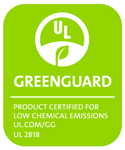 It’s not news that there exist many, many labels out there that hope to convey low-risk or sustainability credentials to consumers (B2C) and/or buyers (B2B).
It’s not news that there exist many, many labels out there that hope to convey low-risk or sustainability credentials to consumers (B2C) and/or buyers (B2B).
Some of these are indeed so specialised, or hidden within the larger context, that indeed few people have seen or taken note of it.
One such label is the Greenguard certification, which is focused entirely onto remedying negative health impacts in interior spaces: from furniture, to interior textiles, air filters, adhesives, flooring and floor finishes etc.
It is a certification and label that is particularly popular in the US, and, there, specifically in products targeting or used by children at any age. The product guide available on the website seems to have indeed evolved in a buying guide for many aware US households.
Although GreenGuard was not designed specifically for fabrics, it is often advertised that a fabric is GreenGuard certified, because GreenGuard certified products can automatically meet the requirements of LEED 2009 CI Credit 4.5 and BIFMA X7.1. (Source: O Ecotextiles)
What is the main issue that the label addresses?
Greenguard is all about air quality, and the remediation of potential negative or even dangerous related health impacts.
In their own words “the GREENGUARD Certification Program gives assurance that products designed for use in indoor spaces meet strict chemical emissions limits, which contribute to the creation of healthier interiors. Achieving GREENGUARD Certification gives credence to manufacturers’ sustainability claims, backing them with empirical scientific data from an unbiased, third-party organization.”
In the process of certification, emission levels – legal as well as those e.g. known to trigger allergies or similar – are researched and tested. The following chemicals are the main (but not only) components that the tests are assessing: formaldehyde, aldehyde, volatile organic compounds (VOC) and thylates. Most of these chemicals stem from furniture or building structures such as floors, windows, walls and are a result of synthetics of all types being used part of the building materials. These synthethics off-gass over time – in function of humidity, usage etc. – and are released into the indoor air of a building and room. Firm part of the certification process is hence emission modelling, that aims at showing how much and at what rate all these factors influence the release of such chemical compounds into the air, and whether or not it may potentially cause reactions, or else are within ranges where individuals, children in particular, will not be negatively affected in any way.
Maximum allowable emission levels in air concentrations, according to their website, are based on those required by the state of Washington‘s indoor air quality program for new construction, the U. S. EPA’s procurement specifications, the recommendations from the World Health Organization, Germany’s Blue Angel Program, LEED for New Construction (LEED-NC) and LEED for Commercial Interiors (LEED-CI).
There exist 3 types of certification:
- Greenguard certified:
- a certification that assumes that the equipment will be used in locations frequented primarily by adults of average health (Indoor Air Quality Level 1).
- Greenguard Gold: a certification that assumes that the equipment will be used in locations frequented primarily by children of average health (Indoor Air Quality Level 2).
- Greenguard Building Construction is the newest of the family and addresses a common problem of new construction project: It is a building certification program for newly constructed multifamily and commercial properties that follows best practice guidelines for preventing mold and moisture intrusion during design, construction and ongoing operations.
What does Greenguard NOT measure
Greenguard does not
- measure any of the heavy metals (lead, mercury, copper, etc.), such as those used in fabric dyestuffs, because they are not emitted at standard indoor air conditions;
- measure PVC, which is a polymer and therefore not volatile (however, some PVC based product types have a special formulation which enables them to meet GreenGuard standards);
- measure phthalates except in the Children and Schools certification; phthalates are semi volatile, and don’t begin to evaporate until approximately 7 days after exposure to the air.
- evaluate the manufacture of a product, nor any byproducts created during production or disposal
- evaluate any social justice issues
- not evaluate carbon footprint issue
(Source: O Ecotextiles)
What products can be labelled?
The following is a complete list of specific product types and classes that at this current time can be certified for their impact on indoor air quality.
Adhesives/Sealants, Air Filters, Bathroom Products, Building Construction Materials, Cabinetry, Ceiling Systems
Cleaning Products/Systems, Countertops, Doors, Electronics, Floor Finish, Flooring, Furniture, Gymnasium Equipment, Insulation, Mattresses & Bedding, Medical Devices, Paints and Coatings, Panels, Plastic Fabrication
Signage, Storage Solutions, Surfacing Materials, Textiles, Visual Display Products, Wall Finish, Window Treatments (Source: Greenguard website)
How much does it cost?
There is no information available on the organisation’s website, however, in an online resource dating from 2009, the following indications where made:
“Fees charged to participating manufacturer’s in the GREENGUARD Certification ProgramSM vary depending upon a couple of reasons; certification and testing. The certification fee takes into account company size and administrative, application and licensing fees. Testing, which is not conducted by the GREENGUARD Environmental Institute, but is required for certification, will also vary depending on the number of products a manufacturer is looking to have certified and the amount of testing that is needed.”
What is the impact of the label?
Going back to the introduction: While the certification is as good as unknown on Europe, in the US it seems to be a relevant player in the interior’s market, notably in the children’s products area.
With a growing awareness of the problematic impact of indoor air quality on children’s (but also the elderly’s) health, in can be expected that this certification will gain even more followers, notably as they are working at branching into areas such as contract textiles for hospitals and care homes.

